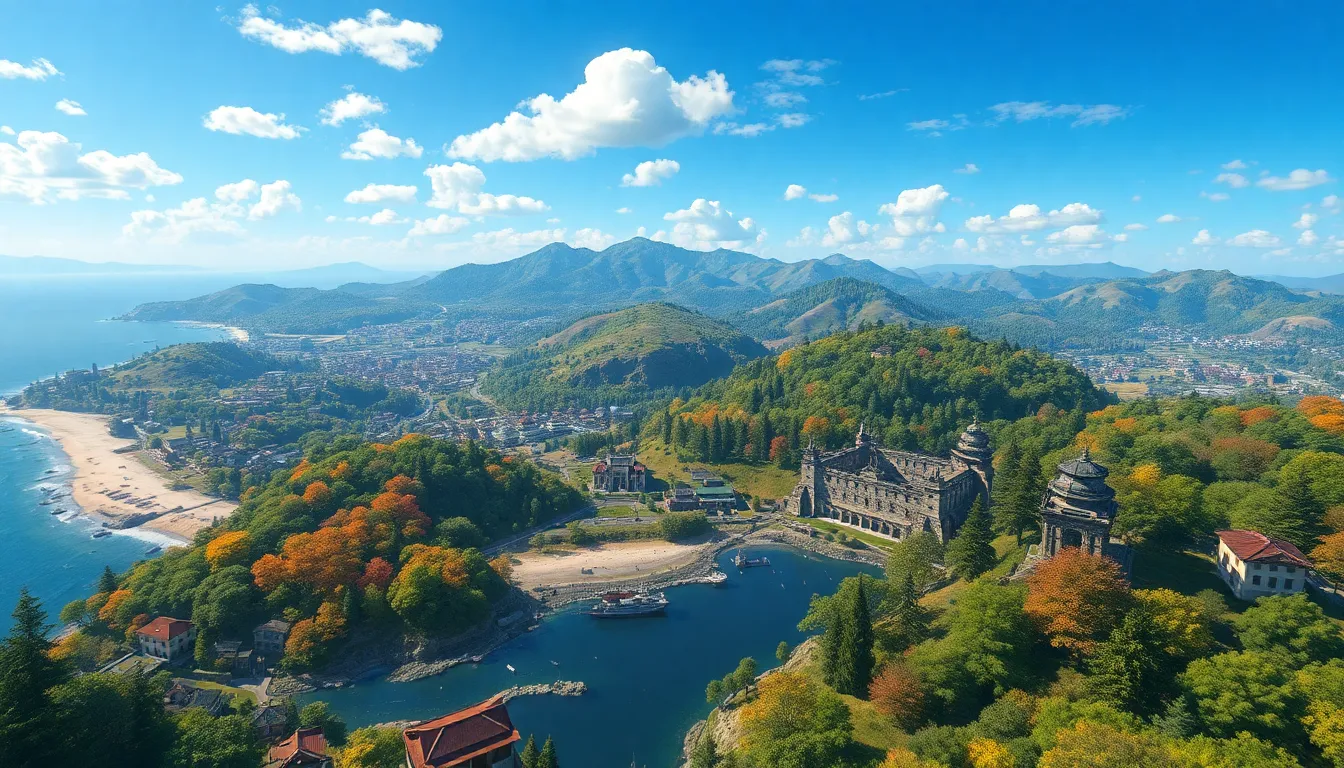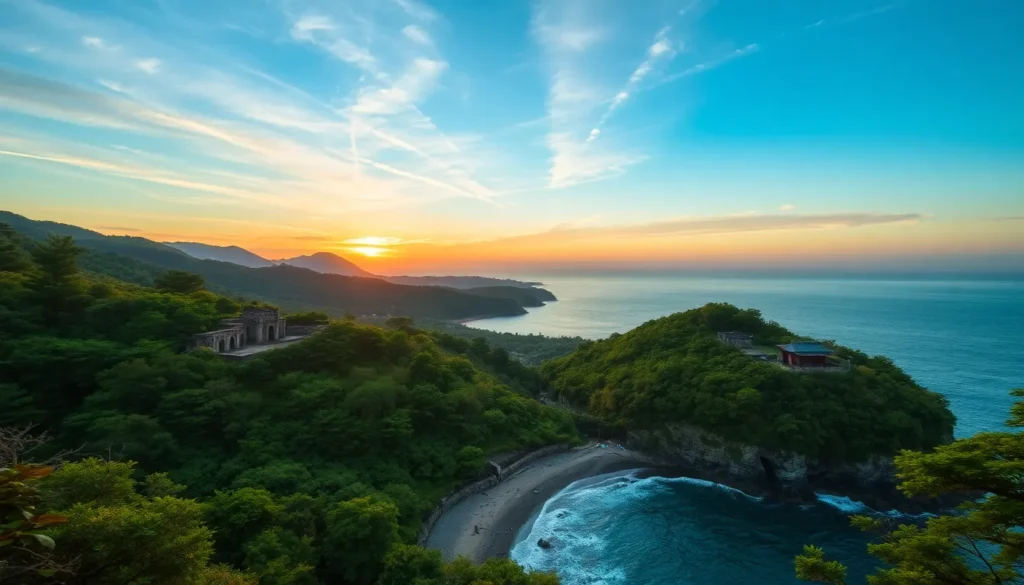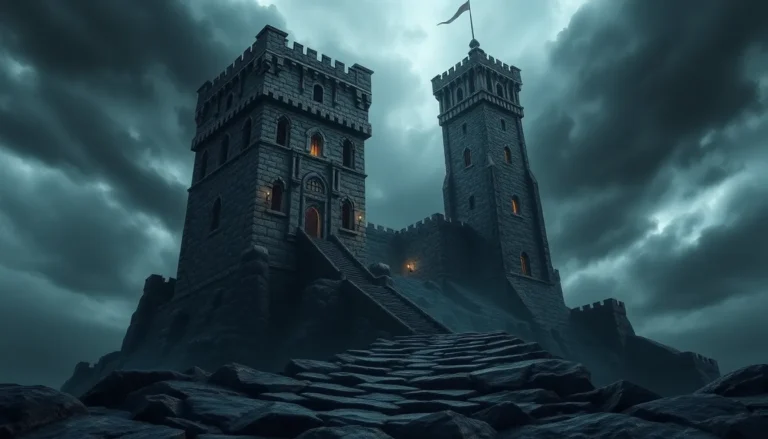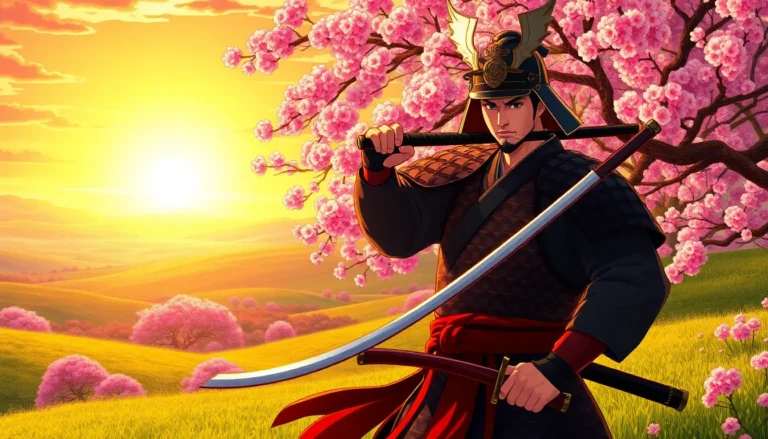Table of Contents
ToggleIn the world of video games, few landscapes captivate players like the stunning map of Tsushima in Ghost of Tsushima. Set against the backdrop of feudal Japan, this expansive open world invites exploration and adventure, immersing players in its rich history and breathtaking scenery. From lush forests to serene beaches, every corner of Tsushima is meticulously crafted to evoke a sense of wonder.
As players traverse the diverse environments, they encounter not only stunning visuals but also a deep narrative that intertwines with the land itself. The game map serves as a canvas for storytelling, where every landmark and hidden path contributes to the overall experience. Discovering the secrets of Tsushima becomes an adventure in itself, making the map an integral part of what makes this game so memorable.
Overview of Tsushima Game Map
The Tsushima game map in Ghost of Tsushima presents a vast open world set in feudal Japan. The designers meticulously crafted diverse environments, which include:
- Lush Forests: Players navigate through dense foliage teeming with wildlife.
- Serene Beaches: Coastal areas offer stunning views while providing opportunities for exploration.
- Rolling Hills: Varied terrain challenges players with elevation changes and scenic vistas.
- Ancient Ruins: Historic sites reveal the island’s rich cultural heritage and add depth to the narrative.
Each region contains unique landmarks, hidden paths, and collectibles, enriching the exploration experience. The map encourages discovery, rewarding players with armor sets, techniques, and lore pieces as they traverse the landscape. Specific locations like the Temple of Heaven and Kiyoshi’s Coast serve as focal points for quests, while lesser-known areas hold secrets that enhance immersion.
With its richly detailed environments and interconnected pathways, the Tsushima game map profoundly impacts gameplay. It not only captivates visually but also integrates with the storyline, inviting players to uncover the island’s history and tales. The combination of beauty and interactivity within the map ensures memorable adventures throughout the game.
Key Features of Tsushima Game Map

The Tsushima game map features a diverse and immersive environment, designed to enhance gameplay and exploration. Players encounter a range of topographical elements and significant landmarks throughout the expansive landscape.
Topography and Landscape
The map presents varied topography, including mountains, valleys, and coastlines. Each region showcases unique landscapes, such as:
- Forests: Dense woodlands filled with wildlife, providing natural resources and a tranquil atmosphere.
- Beaches: Scenic coastlines where players can explore tidal pools and gather materials.
- Hills: Rolling hills that offer panoramic views of the island, enhancing navigation and combat strategy.
- Ruins: Ancient structures that reflect the island’s cultural history, inviting players to unravel their stories.
These elements create a visually stunning backdrop that enhances immersion and player engagement.
Points of Interest
The Tsushima game map contains numerous points of interest that enrich the overall experience. Key locations include:
- The Temple of Heaven: A central site for quests, offering challenges and rewards relevant to the storyline.
- Kiyoshi’s Coast: A beautiful beach area with secrets and collectibles, promoting exploration.
- Hidden Shrines: Scattered throughout the landscape, these shrines provide unlockable techniques and lore.
- Camps and Settlements: Offer opportunities for interactions, crafting, and side missions, contributing to character development.
Each point of interest not only provides gameplay rewards but also deepens the player’s connection to the narrative and the island’s rich history.
Exploration and Gameplay Mechanics
Exploring the Tsushima game map enhances the immersive experience in “Ghost of Tsushima.” Players interact with a beautifully designed open world that fosters a sense of adventure and discovery. The mechanics of exploration and navigation play a vital role in making each journey memorable.
Open World Design
The open world design of Tsushima features a rich variety of landscapes that invite players to explore. Locations include dense forests, rolling hills, and dramatic coastlines, creating a visually stunning environment. Each region has distinctive landmarks and hidden treasures that encourage thorough exploration. Notable areas, such as the Temple of Heaven and Kiyoshi’s Coast, not only serve as quest focal points but also immerse players in the narrative. Collectibles like armor sets and lore items are strategically placed, rewarding curious players for their efforts. The interconnected pathways and various terrains create a dynamic gameplay experience, promoting engagement and intrigue across the island.
Fast Travel and Navigation
Fast travel mechanics simplify navigation across Tsushima’s expansive map, allowing players to revisit locations quickly. Players unlock fast travel points by discovering shrines and completing certain objectives. While fast travel expedites movement, on-foot exploration enhances players’ appreciation of the stunning visuals and environment. The use of the guiding wind mechanic further aids navigation, gently directing players toward objectives without interrupting immersion. Players can locate quest markers and points of interest easily while remaining engaged in the world around them. This combination of fast travel and natural navigation ensures a balanced exploration experience, blending convenience with the joy of discovery.
Visuals and Aesthetics
The game “Ghost of Tsushima” showcases remarkable visuals that immerse players in a beautifully rendered version of feudal Japan. The attention to detail enhances the overall gaming experience, creating a vivid world filled with rich aesthetics.
Art Style and Graphics
The art style in “Ghost of Tsushima” blends realism with artistic flair, resulting in a visually stunning environment. Graphics utilize high-resolution textures and dynamic lighting, presenting a world that feels alive. Artistic elements, such as the distinctly designed character models and breathtaking landscapes, form a cohesive atmosphere that captivates players. Subtle animations in foliage and wildlife enhance the realism, while the color palette shifts with seasons, creating a dynamic visual journey.
Environmental Effects
Environmental effects contribute significantly to the immersion in “Ghost of Tsushima.” Dynamic weather patterns, including rain, wind, and fog, dynamically affect gameplay and visuals. The game employs realistic physics, making foliage sway naturally and adding depth to combat. Day-night cycles not only transform the aesthetic landscape but also impact gameplay, altering stealth strategies and enhancing exploration. These effects combine to create a living, breathing world that players can fully engage with, enriching their overall experience in Tsushima.
Comparison to Other Game Maps
Comparing the Tsushima game map to other open-world game maps reveals several distinct features. The expansive nature of the Tsushima map is similar to that of The Witcher 3: Wild Hunt, where players explore a richly detailed environment overflowing with quests and secrets. However, Tsushima differentiates itself with its unique Japanese aesthetic and cultural elements, which provide a deeper immersion into feudal Japan’s history.
The varied topography in Tsushima closely parallels the mountainous landscapes found in Horizon Zero Dawn. Both maps feature dynamic terrains that encourage exploration and tactical gameplay. While Horizon Zero Dawn focuses on technological ruins, Tsushima emphasizes natural beauty and historical landmarks, enhancing the player’s connection to the island’s narrative.
In terms of map design, Tsushima offers a more guided experience compared to Red Dead Redemption 2. The guiding wind mechanic streamlines navigation across terrains without the clutter of traditional maps, allowing players to engage with the environment organically. This approach contrasts with the intricate map system of Red Dead Redemption 2, which can overwhelm with sheer detail and numerous side quests.
Moreover, Tsushima’s commitment to environmental storytelling outshines other game maps, such as in Assassin’s Creed Odyssey. While both games utilize open environments to convey stories, Tsushima excels in creating a cohesive narrative through its landscapes, where each area holds historical significance and contributes to the overarching storyline.
Overall, Tsushima stands out among open-world games for its beautiful aesthetics, engaging exploration mechanics, and historical depth. Its map design prioritizes player immersion and narrative connection, setting a high standard in the realm of video game worlds.
The Tsushima game map stands as a remarkable achievement in video game design. Its breathtaking landscapes and intricate details invite players to immerse themselves in the rich history of feudal Japan. Every corner of the map offers unique experiences that enhance both gameplay and storytelling.
Players are encouraged to explore the diverse environments and uncover hidden treasures that deepen their connection to the narrative. The seamless blend of stunning visuals and engaging mechanics creates an unforgettable adventure. Tsushima not only captivates with its beauty but also sets a new benchmark for open-world exploration in gaming.





